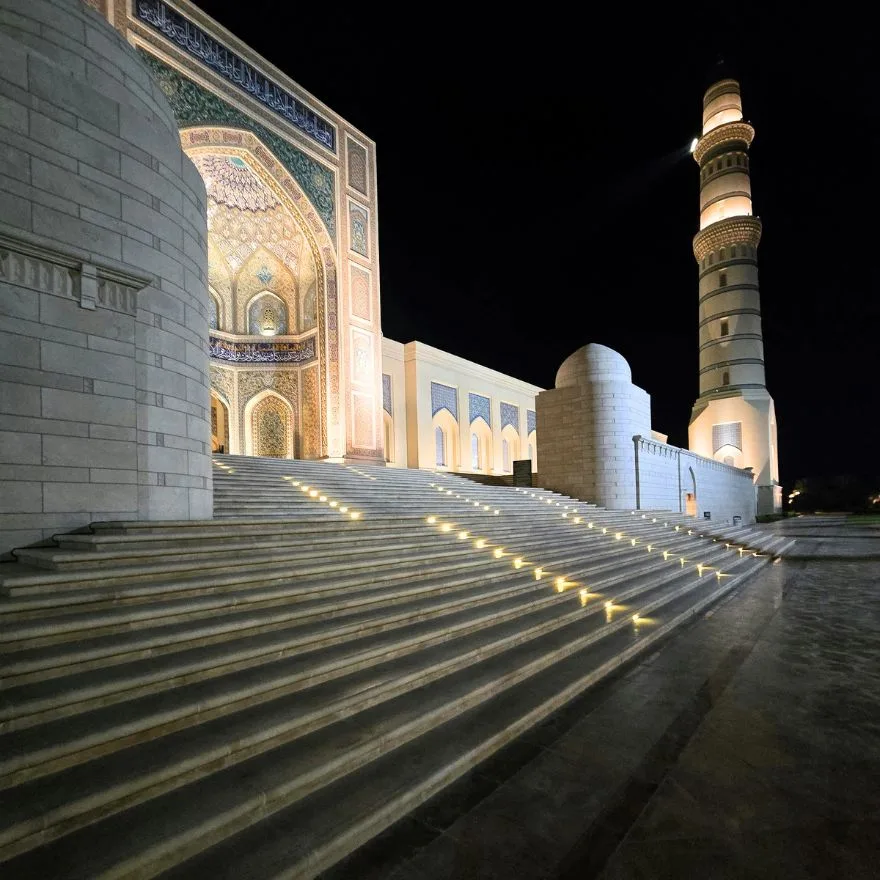Finding the quiet magic between dunes and harbor—an intimate, practical, and lyrical guide to Muscat.

Introduction — Dawn Between Mountain and Sea
If you arrive at dawn in Muscat, Oman, you will notice something small and stubbornly beautiful: the city does not announce itself. Instead, it reveals itself slowly—light touching whitewashed facades, the hush of fishing boats, and a wind that carries the sweet, ancient smoke of frankincense. This is a capital that balances the desert and the sea with a quiet dignity. It is a place where hospitality is not a commodity but a tradition, and where time feels wider, as if there were room for both memory and possibility.
Before we walk the Mutrah Corniche or stand beneath the glittering dome of the Sultan Qaboos Grand Mosque, let us set the map gently: this guide blends poetic observation with practical advice—things to do in Muscat, the best time to visit, where to eat, and a few day trips that promise the hidden heart of Oman. Read slowly, and leave room in your itinerary for lingering.
A Dance with Time: The Story of Muscat
Muscat’s story is maritime. For millennia its natural harbor welcomed vessels from East Africa, Persia, India, and beyond. Its strategic position on the Gulf of Oman and the Arabian Sea made it a prize for foreign powers—Portuguese watchtowers still punctuate the coastline—and a crossroads where spices, textiles, pearls, and ideas changed hands.
The name Muscat is often associated with anchorage and shelter, a fitting echo of how the city has long protected seafarers and traders. Archaeological traces attest to ancient human presence in the region; later, during the Sassanid era and across subsequent centuries, Muscat grew in significance as a port and a cultural hinge.
In the modern era, transformation began under Sultan Qaboos bin Said in 1970. In a few decades Oman built roads, hospitals, schools, and cultural institutions while preserving its heritage. That balance—progress with preservation—is visible across Muscat: contemporary comforts framed by low-rise, traditionally influenced architecture rather than towering glass giants.
Best Time to Visit Muscat
The best time to visit Muscat is October to April, when the air is kinder—mild days and cooler nights invite exploration. Daytime temperatures hover around 24–29 °C (75–85 °F), perfect for strolling souqs, hiking coastal paths, or dining outdoors.
Summer (May – September) brings heat and humidity. If your style favors quiet beaches and shaded pools, summer has its own spell. Note that Oman’s southern province, Dhofar, transforms under the Khareef monsoon—a misty green world that, while distant from Muscat, makes an unforgettable detour.
During Oman National Day (18 December) the city glows with flags and music—an inspiring time to visit though hotels fill quickly.
Top 5 Places to Visit in Muscat
1. Sultan Qaboos Grand Mosque
Completed in the early 2000s, the mosque is both sanctuary and masterpiece. Visit in the morning when light paints marble and mosaic. Non-Muslims are welcome during specific hours—modest dress required (women cover hair and arms; men wear long trousers). Inside, the vast hand-woven carpet and glittering chandelier speak of craftsmanship and faith in quiet harmony.
2. Mutrah Corniche & Souq
Walk the Mutrah Corniche at dusk as dhows rock gently in harbor light. Then slip into the Mutrah Souq, one of Arabia’s oldest markets, where incense and spice mingle with silver khanjars and textiles. Bargaining is part art, part friendship—linger for Omani coffee and conversation.
3. Royal Opera House Muscat
This marble jewel hosts world-class performances and Omani music alike. Even a guided tour reveals how modern artistry and tradition meet beneath carved wood and polished stone.
4. Bait Al Zubair Museum
A restored house turned museum displaying weaponry, costumes, photographs, and household artifacts—an intimate window into everyday Omani life and the genius of adaptation to climate and terrain.
5. Qurum Beach & Natural Park
Golden sands, calm waves, and nearby gardens make Qurum Beach ideal for morning walks or sunset reflection. Families gather as light softens, and the scent of frankincense mingles with sea salt.
Beyond the City: Day Trips & Hidden Valleys
Muscat makes a gentle base for wandering. Rent a car and the landscape unfolds: the Hajar Mountains rise inland while the coast curls toward coves and fishing towns.
Recommended day trips:
- Wadi Shab – hike and swim through turquoise pools to a secret waterfall cave.
- Wadi Bani Khalid – accessible oasis framed by date palms.
- Quriyat Coastal Road – serene drive through villages and cliffs.
- Ras al Jinz Turtle Reserve – night tours to witness nesting sea turtles.
- Jebel Akhdar (Sayq Plateau) – cool mountain air and terraced orchards, ideal in cooler months.
Each excursion rewards the traveler who moves slowly, who pauses for roadside tea or a conversation beneath a palm’s shade.
Omani Hospitality & Culture
Hospitality in Oman is a language of welcome. Expect invitations to share coffee and dates. “Ahlan wa sahlan” — welcome — echoes everywhere. Coffee is poured into small cups, halwa offered, and conversation unfolds unhurriedly.
Muscat’s society is diverse yet grounded. Dress modestly in public, and always ask permission before photographing people—especially women. Respect earns warmth; curiosity earns stories.
Flavors of Arabia: What & Where to Eat
Omani cuisine sings softly but stays long in memory:
- Shuwa – slow-roasted lamb cooked underground, tender and smoky.
- Harees – wheat and meat porridge, simple and comforting.
- Makbous – spiced rice layered with meat or fish.
- Mashuai & Samak Matrouba – coastal fish dishes with lemon or coconut.
- Halwa – rose-scented, saffron-tinted sweet paired with coffee.
Try small, family-run restaurants near Mutrah or Al Khuwair, where recipes are family stories. For street flavor, sample mishkak (grilled skewers) in the evening breeze.
Navigating Muscat: Travel Tips
- Visa: Most nationalities can obtain an e-visa online. Apply early.
- Transport: Public buses are limited. Renting a car offers freedom and access to wadis and mountains.
- Currency: Omani Rial (OMR) ≈ 2.6 USD. Cards accepted; cash useful for souqs.
- Language: Arabic official; English widely spoken. Learn a few phrases—Shukran, Salam, Ma’a salama.
- Etiquette: Dress modestly; during Ramadan avoid public eating in daylight.
- Photography: Always ask before taking photos of people.
- Health: Stay hydrated, use sunscreen, and carry water on day trips.
DiscoverCars — Make the Road Part of Your Story
For those who yearn to drift from Muscat’s beaches toward hidden mountain wadis, a rental car turns the journey itself into discovery. Through DiscoverCars, compare trusted options—from compact sedans for city cruising to SUVs ready for mountain passes. With your own wheels, day trips to Wadi Shab, the Hajar Mountains, or the coastal cliffs of Quriyat become effortless poetry—freedom traced in asphalt and sand.
FAQs — Quick Answers for Travelers
What is the best time to visit Muscat?
Between October and April, when weather is gentle and outdoor life flourishes.
Do I need a visa for Oman?
Most travelers can apply online for an e-visa; check official requirements before flying.
Is Muscat family-friendly?
Yes—beaches, parks, and calm neighborhoods make it welcoming for all ages.
Can I drink alcohol in Muscat?
Only in licensed hotels or restaurants. Public drinking is prohibited.
Is it safe to drive in Oman?
Roads are well-maintained; drive cautiously on mountain roads and avoid wadis during heavy rain.
Where Desert Meets Sea, Where Spirit Soars
Muscat is not a city of extremes—it is a city of pause. The hush before prayer, the slow pour of cardamom coffee, the gentle bargaining of a merchant who remembers your name.
Travel here with patience and the city will open like a shell revealing light. Between desert and sea you will find not only a destination but a rhythm: calm, grounded, and enduring.
— Inner Soar

